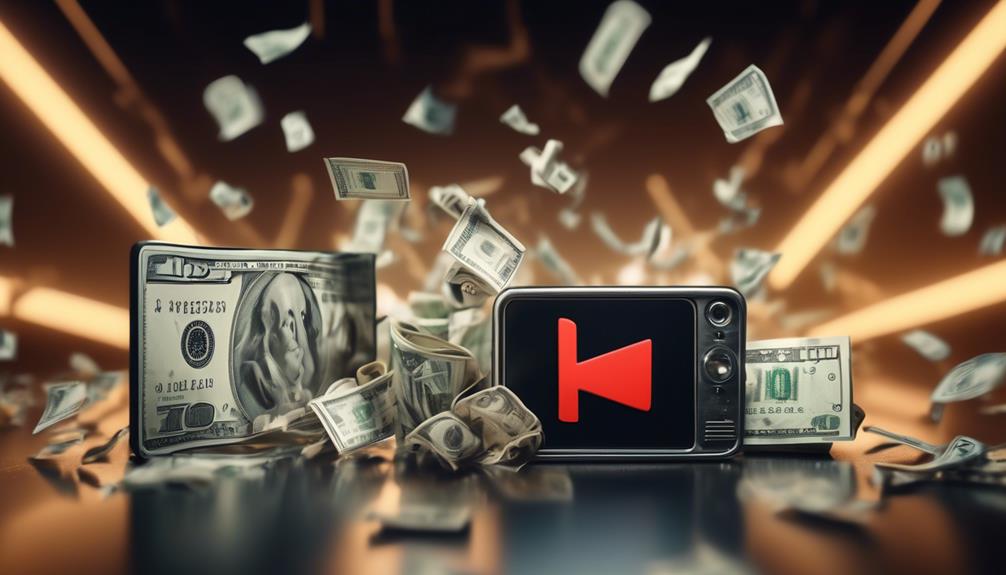
Does YouTube pay for views or likes?
‘There’s no such thing as a free lunch,’ goes the saying, and in the world of YouTube, this adage holds true.
You’ve probably wondered whether YouTube pays for views or likes, and if so, how much? The truth of the matter is more complex than a simple ‘yes’ or ‘no’.
YouTube’s payment structure is tied to a variety of factors, and understanding these can help you make the most of your channel.
So, are you ready to unravel the mystery and discover what it takes to earn on this popular platform?
Key Takeaways
- YouTube pays creators based on ad revenue generated from monetized views, not directly for views or likes.
- Views and likes play a crucial role in channel growth and success, as they contribute to higher view counts, engagement, and visibility.
- Higher view counts can lead to increased ad impressions and clicks, resulting in higher earnings for creators.
- In addition to ad revenue, creators can explore alternative income streams such as channel subscriptions, influencer marketing, affiliate marketing, brand collaborations, and crowdfunding.
Understanding YouTube Monetization

To fully grasp how YouTube’s monetization works, you need to understand that it’s not just about views or likes, but involves a complex combination of factors, including ad revenue, channel subscriptions, and partnerships. It’s a web of interconnected strategies, and your ability to navigate it can significantly impact your income.
Monetization eligibility is a crucial element of this. To start earning, you need to hit certain milestones, such as 1,000 subscribers and 4,000 watch hours in the past 12 months. You’ve also got to comply with all of YouTube’s policies and guidelines—a breach could result in demonetization.
Now, let’s touch upon the controversies surrounding monetization. You might’ve heard of instances where creators felt they were unfairly demonetized. This often occurs due to the automated systems YouTube uses to vet content for ad appropriateness. It’s a tricky balance—maintaining a platform that’s both brand-friendly and creator-friendly.
In your monetization strategy, remember to innovate. There’s more to YouTube than ad revenue. Consider channel memberships, merchandise shelf, Super Chat, and more. By diversifying your income streams, you’re not only maximizing your earning potential but also safeguarding against potential algorithm shifts or policy changes.
The Importance of YouTube Views
When it comes to YouTube, you can’t underestimate the importance of views. They’re a vital part of how YouTubers generate income and impact their overall success.
In fact, a higher view count can significantly boost your earnings and influence on the platform.
Earning Through Views
Understanding the revenue potential of YouTube views is crucial as they directly influence your earning potential on the platform. The video quality importance can’t be overstated. High-quality content drives engagement, keeping viewers on your video longer, which positively impacts the YouTube algorithm.
The subscriber influence is also significant. Subscribers often equate to a built-in audience for your videos, leading to a higher view count. Remember, YouTube’s payment structure is fundamentally view-based.
Strategically, you should focus on increasing both the quality of your videos and your subscriber count to maximize earnings. Harness data insights to understand what content resonates with your audience. By optimizing these factors, you can significantly boost your earning potential through views.
Innovation is key in this rapidly evolving platform.
View Count Impact
Drilling down into the specifics, it’s clear that the impact of view count on your YouTube earnings can’t be underestimated.
- Algorithm Influence: YouTube’s algorithm prioritizes videos with higher view counts, directing more traffic to them. More views lead to more opportunities for ad impressions and clicks, increasing your earnings.
- Audience Appeal: A high view count signals to new viewers that your content is worth watching, attracting even more viewers.
- Ad Revenue: More views translate into more ad impressions, and consequently, more revenue.
- Regional Restrictions: Your view count also depends on the geographic location of your viewers. There might be restrictions on ad availability or monetization in certain regions, which can affect your earnings.
YouTube Likes: Do They Matter?

You might be wondering, ‘Do YouTube likes really matter?’
When looking at data, it’s clear that while likes don’t directly influence earnings, they play a significant role in channel growth and video promotion.
Importance of YouTube Likes
In the YouTube ecosystem, likes act as a crucial metric, playing a strategic role in elevating the visibility and popularity of your videos. They carry social influence implications, underlining your standing in the community, and form a cornerstone of audience retention strategies.
Here’s how it works:
- Boosts ranking: More likes improve your video’s position in search results.
- Encourages engagement: Likes act as social proof, nudging more viewers to interact.
- Enhances channel credibility: A higher like count signifies quality content, bolstering your reputation.
- Facilitates recommendations: YouTube’s algorithm favors videos with more likes, leading to more recommendations.
Strategically, likes aren’t just a vanity metric. They’re an innovative tool to maximize your video’s reach and impact.
Likes Impact on Earnings
Despite their influence on channel credibility and viewer engagement, likes alone don’t directly contribute to your YouTube earnings. However, they aren’t inconsequential. A ‘like for like’ strategy can boost your channel’s visibility, indirectly increasing potential ad revenue.
The link is indirect but powerful, enhancing your channel’s appeal to advertisers seeking innovative, engaging content.
Understanding your audience demographics is vital. It’s not just about the number of likes, but who’s liking your content. Are they part of the demographic that advertisers are keen to reach? If yes, you’re more likely to secure premium ad rates.
It’s strategic, data-driven logic: more likes from the right audience can equal more revenue. So, while likes aren’t currency, they’re certainly an asset in the YouTube earnings game.
YouTube’s Payment Structure Explained
Understanding YouTube’s payment structure requires a detailed analysis of its revenue models, namely advertising and channel subscriptions. Video copyright complexities and the impact of non-monetized content also play significant roles.
- Advertising Revenue: YouTube’s primary revenue comes from ads. You earn a share of the ad revenue for every monetized view on your videos, which is determined by factors such as video length and viewer interaction.
- Channel Subscriptions: YouTube offers channels the option to charge a subscription fee. As a creator, you’d get a cut from these fees, providing a steady income stream.
- Video Copyright Complexities: If your content infringes on copyright rules, any potential earnings could be claimed by the copyright owner. It’s essential to understand these complexities to ensure your content remains profitable.
- Non-Monetized Content Impact: Not all views generate revenue. Non-monetized views, such as those from users with ad blockers, won’t contribute to your earnings.
Role of Advertisements in Earnings

Diving into the realm of YouTube earnings, it’s pivotal to grasp how advertisements significantly contribute to a channel’s income. Advertisements are key players in your ad revenue breakdown. They’re not just pesky interruptions to your viewers; they are also potential money-makers for you.
Every time a viewer watches at least 30 seconds of an ad or interacts with it, you earn a portion of the revenue. But remember, it’s not solely about views. The type of ad, the viewer’s location, and even the device used for viewing can impact your earnings.
Influencer marketing also plays a crucial role. Brands often pay influencers directly to showcase their products or services. This is separate from YouTube’s ad revenue but still contributes to your total income. Here’s a simplified breakdown:
| Revenue Source | Impact on Earnings |
|---|---|
| Ad Views | Varies based on ad type, viewer location, and device |
| Ad Interactions | Increases with viewer engagement |
| Influencer Marketing | Direct payment from brands, not reliant on views |
Strategize your content and advertisements to maximize these revenue streams. Your earnings depend not just on views and likes, but also on the strategic use of ads and influencer marketing.
Decoding YouTube’s Partner Program
Let’s now turn our attention to YouTube’s Partner Program, a critical component of their monetization strategy.
You need to understand the criteria for partnership and how it directly affects your potential earnings.
This knowledge will enable you to strategically optimize your content for better revenue outcomes.
Understanding YouTube’s Monetization
Before you can fully grasp how YouTube’s monetization model operates, it’s crucial to decode the complexities of YouTube’s Partner Program. This program encompasses several aspects, including ad blocker effects and copyright issues.
- Ad Blocker Effects: Ad blockers can significantly reduce the revenue you earn from ads. YouTube can’t pay you for views that don’t see ads, hence, more ad blockers equate to fewer earnings.
- Copyright Issues: If you violate copyright laws, any revenue generated goes to the copyright owner, not you.
- Revenue Streams: YouTube’s Partner Program provides different ways to earn money, including ad revenue, channel memberships, and merchandise shelf.
- Eligibility Requirements: You need to meet specific criteria to be eligible for monetization.
Understanding these components can help you craft a more effective YouTube strategy.
Criteria for Partnership
To tap into YouTube’s Partner Program’s potential, you must first clear some essential eligibility hurdles. It’s not just about creating content; it’s about understanding and meeting YouTube’s partner eligibility criteria. Here’s a quick rundown in a handy table:
| Criteria | Description |
|---|---|
| Account standing | Your account must be in good standing, with no policy violations. |
| Residency | You need to reside in a country where the Partner Program is available. |
| Video views | You’ve to garner at least 4,000 valid public watch hours in the last 12 months. |
| Subscriber base | You must have more than 1,000 subscribers. |
These requirements ensure a fair revenue split and encourage creators to produce high-quality, innovative content. So, strategize your content to meet these criteria and unlock the potential of YouTube’s Partner Program.
Impact of Viewer Engagement on Earnings

Often, the level of viewer engagement directly influences your earnings on YouTube. Subscriber influence and engagement algorithms play pivotal roles in determining this income.
- Subscriber Influence: The more subscribers you have, the higher your potential to earn. Subscribers represent a consistent viewer base that generates regular views, likes, and shares. These engagements boost your visibility, increasing the likelihood of attracting advertisers.
- Engagement Algorithms: YouTube uses complex algorithms to measure viewer engagement. These metrics include watch time, likes, comments, shares, and even the number of times your video is added to a ‘Watch Later’ list. The algorithm favors high-engagement channels, promoting them to potential viewers.
- Viewer Retention: The longer your viewers stay, the more ads they’re likely to watch. This increases your ad revenue. Strategically place engaging content throughout your video to encourage viewers to stay longer.
- Click-Through Rate: The number of viewers that click on your video after seeing it in their feed impacts your earnings. High click-through rates signal to YouTube that your content is appealing, prompting the platform to suggest it to more users.
YouTube Premium and Its Influence
While you’re focusing on regular ad revenue, don’t overlook the potential earnings from YouTube Premium. This subscription-based service, with its premium exclusivity, opens up a new revenue stream that’s not dependent on ads. YouTube Premium members pay a monthly fee for ad-free viewing and other benefits, a portion of which is funneled back to creators based on viewer engagement.
Dive into the data, and you’ll find that YouTube Premium can substantially boost your earnings. For instance, if a Premium user spends more time on your content, you’ll earn more from their subscription fee. It’s not about views or likes, but the sheer amount of watch time.
Capitalizing on the subscription benefits of YouTube Premium requires a strategic approach. The content you create needs to have a high engagement rate to maximize earnings from Premium users. Think innovation, think exclusivity. This is your chance to offer something unique and compelling that keeps viewers coming back.
Sponsorships and Direct Monetization Methods

Beyond ad revenue and YouTube Premium earnings, you can significantly boost your income through sponsorships and other direct monetization methods. These strategic avenues aren’t only a lucrative income stream but also an innovative approach to leverage your influence and reach. Here are four key direct monetization methods:
- Brand Collaborations: This involves partnering with brands for product placement or reviews in your videos. You’re paid per video or through a revenue share model.
- Influencer Marketing: Brands pay you to promote their products or services to your subscribers. It’s a data-driven approach that significantly increases brand visibility and sales.
- Affiliate Marketing: You promote a product and earn commission from any sales made through your referral link.
- Crowdfunding and Donations: Platforms like Patreon allow your fans to financially support your content creation.
Analyzing your audience demographics and engagement metrics can guide you in choosing the most suitable monetization strategy. Remember, it’s not just about increasing your income, but also about offering relevant, value-added content to your viewers.
Direct monetization methods, when strategically employed, can create a win-win situation for you, your viewers, and your brand partners.
Factors Affecting YouTube Revenue
Unsurprisingly, your YouTube revenue isn’t just about the number of views or likes; several other factors come into play. These include your content copyright and subscription revenue, among others.
Content copyright is critical. If you’ve original content, you can monetize it. However, if your content involves copyrighted material, you may face restrictions or outright demonetization. Therefore, creating unique, innovative content is vital for maximizing your revenue.
Subscription revenue is another significant factor. If your channel offers premium content, you can encourage viewers to subscribe for a fee. This provides a steady revenue stream, beyond ad revenue. The higher the subscription base, the higher your income. It’s a strategic move to diversify your YouTube income.
Your video’s length also impacts revenue. Longer videos can host more ads, leading to increased earnings. But remember, engagement is key. If your content doesn’t hold viewers’ attention, the extra ads won’t pay off.
Lastly, the geographic location of your viewers affects your earnings. Advertisers pay more for viewers in certain regions, usually developed countries.
Tips for Increasing YouTube Earnings

To ramp up your YouTube earnings, it’s crucial to implement strategic, data-driven tactics that boost both viewership and engagement on your channel. The digital landscape is ripe with opportunities for innovation, making it possible for you to capitalize on your content.
- Keyword Optimization: Leverage YouTube’s algorithm to your advantage by incorporating relevant keywords into your video titles, descriptions, and tags. This improves searchability and visibility, leading to increased views.
- Consistent Content Creation: Regularly uploading high-quality content cultivates an engaged subscriber base. This not only boosts your views but also improves your chances of earning from advertisements.
- Affiliate Marketing: Promote products or services within your videos and provide affiliate links in the description. Each time a viewer makes a purchase through your link, you earn a commission. This is a proven method to supplement your YouTube revenue.
- Brand Collaborations: Partner with brands to create sponsored content. These partnerships not only provide direct earnings but also expose your channel to the brand’s audience, potentially increasing your subscriber count.
Successful Monetization: Real-life Examples
Implementing these strategies has proven successful for many YouTubers, as evidenced by multiple real-life examples of effective monetization. Take PewDiePie, for instance. With viral video strategies, he’s earned millions by creating engaging, shareable content. He’s also leveraged influencer collaborations, partnering with other popular YouTubers to maximize visibility and increase his subscriber base.
Another example is Casey Neistat. He uses high-quality storytelling and consistent content posting to maintain a solid viewership. His influencer collaborations, like the one with Mercedes-Benz, have significantly boosted his earnings.
Analyzing their strategies, it’s clear that smart content creation, coupled with strategic collaborations, can lead to substantial monetization. But remember, it’s not just about getting views and likes; it’s about creating a loyal audience that’ll engage with your content and brands you partner with.
For you, this could mean experimenting with different video strategies, studying your analytics to understand what works best, and seeking out collaborations that align with your brand. There’s no one-size-fits-all strategy, so stay innovative, keep testing, and let your data guide you.
In the world of YouTube monetization, it pays to be strategic, data-driven, and willing to take calculated risks.

